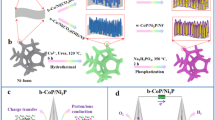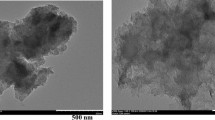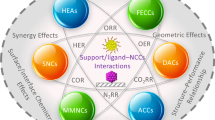Abstract
The synthesis of atomic-scale metal catalysts is a promising but very challenging project. In this work, we successfully fabricated a hybrid catalyst of Ptc/Ni(OH)2 with atomic-scale Pt clusters uniformly decorated on porous Ni(OH)2 nanowires (NWs) via a facile room-temperature synthesis strategy. The as-obtained Ptc/Ni(OH)2 catalyst exhibits highly efficient hydrogen evolution reaction (HER) performance under basic conditions. In 0.1 mol L−1 KOH, the Ptc/Ni(OH)2 has an onset overpotential of ~0 mV vs. RHE, and a significantly low overpotential of 32 mV at a current density of 10 mA cm−2, lower than that of the commercial 20% Pt/C (58 mV). The mass current density data illustrated that the Ptc/Ni(OH)2 reached a high current density of 6.34 Amg −1Pt at an overpotential of 50 mV, which was approximately 28 times higher than that of the commercial Pt/C (0.223 A mg −1Pt ) at the same overpotential, proving the high-efficiency electrocatalytic activity of the as-obtained Ptc/Ni(OH)2 for HER under alkaline conditions.
摘要
合成原子级别的催化剂是一项颇具前景但又充满挑战的课题. 本文通过简单的室温反应成功制备了一种原子级别的Pt团簇修饰 的多孔α相氢氧化镍纳米线(Ptc/Ni(OH)2)复合材料. 所得到的Ptc/Ni(OH)2在碱性环境下表现出高效的电催化析氢反应性能. 在氢气饱和 的0.1 mol L−1氢氧化钾溶液中, Ptc/Ni(OH)2的起始过电势很小, 接近于0, 当电流密度为10 mA cm−2时, 其过电势低至32 mV. 此过电位低于同等 条件下商业化20% Pt/C的过电势(58 mV). 通过质量电流密度数据显示, 在过电势为50 mV时, Ptc/Ni(OH)2的质量电流密度高达6.34 A mg, Pt 1 在 同样的过电势条件下, 这一电流是商业化Pt/C (0.223 A mg ) Pt 1 的28倍, 表明我们所制得的Ptc/Ni(OH)2在碱性环境下具有高效的电催化析氢反 应性能.
Similar content being viewed by others
References
Turner JA. Sustainable hydrogen production. Science, 2004, 305: 972–974
Yang H, Zhang Y, Hu F, et al. Urchin-like CoP nanocrystals as hydrogen evolution reaction and oxygen reduction reaction dual-electrocatalyst with superior stability. Nano Lett, 2015, 15: 7616–7620
Blakemore JD, Crabtree RH, Brudvig GW. Molecular catalysts for water oxidation. Chem Rev, 2015, 115: 12974–13005
Esswein AJ, McMurdo MJ, Ross PN, et al. Size-dependent activity of Co3O4 nanoparticle anodes for alkaline water electrolysis. J Phys Chem C, 2009, 113: 15068–15072
Jin H, Wang J, Su D, et al. In situ cobalt–cobalt oxide/N-doped carbon hybrids as superior bifunctional electrocatalysts for hydrogen and oxygen evolution. J Am Chem Soc, 2015, 137: 2688–2694
Luo J, Im JH, Mayer MT, et al. Water photolysis at 12.3% efficiency via perovskite photovoltaics and Earth-abundant catalysts. Science, 2014, 345: 1593–1596
Lu Q, Hutchings GS, Yu W, et al. Highly porous non-precious bimetallic electrocatalysts for efficient hydrogen evolution. Nat Commun, 2015, 6: 6567
McKone JR, Sadtler BF, Werlang CA, et al. Ni–Mo nanopowders for efficient electrochemical hydrogen evolution. ACS Catal, 2013, 3: 166–169
Raj IA, Vasu KI. Transition metal-based hydrogen electrodes in alkaline solution—electrocatalysis on nickel based binary alloy coatings. J Appl Electrochem, 1990, 20: 32–38
Crnkovic F. Electrochemical and morphological studies of electrodeposited Ni–Fe–Mo–Zn alloys tailored for water electrolysis. Int J Hydrogen Energ, 2004, 29: 249–254
Xu YF, Gao MR, Zheng YR, et al. Nickel/nickel(II) oxide nanoparticles anchored onto cobalt(IV) diselenide nanobelts for the electrochemical production of hydrogen. Angew Chem Int Ed, 2013, 52: 8546–8550
Gong M, Zhou W, Tsai MC, et al. Nanoscale nickel oxide/nickel heterostructures for active hydrogen evolution electrocatalysis. Nat Commun, 2014, 5: 4695
Fei H, Yang Y, Peng Z, et al. Cobalt nanoparticles embedded in nitrogen-doped carbon for the hydrogen evolution reaction. ACS Appl Mater Interfaces, 2015, 7: 8083–8087
Yan X, Tian L, He M, et al. Three-dimensional crystalline/amorphous Co/Co3O4 core/shell nanosheets as efficient electrocatalysts for the hydrogen evolution reaction. Nano Lett, 2015, 15: 6015–6021
Weng Z, LiuW, Yin LC, et al. Metal/oxide interface nanostructures generated by surface segregation for electrocatalysis. Nano Lett, 2015, 15: 7704–7710
Liu P, Zhao Y, Qin R, et al. Photochemical route for synthesizing atomically dispersed palladium catalysts. Science, 2016, 352: 797–800
Yang XF, Wang A, Qiao B, et al. Single-atom catalysts: a new frontier in heterogeneous catalysis. Acc Chem Res, 2013, 46: 1740–1748
Yan H, Cheng H, Yi H, et al. Single-atom Pd1/graphene catalyst achieved by atomic layer deposition: remarkable performance in selective hydrogenation of 1,3-butadiene. J Am Chem Soc, 2015, 137: 10484–10487
Lin J, Wang A, Qiao B, et al. Remarkable performance of Ir1/FeOx single-atom catalyst in water gas shift reaction. J Am Chem Soc, 2013, 135: 15314–15317
Fei H, Dong J, Arellano-Jiménez MJ, et al. Atomic cobalt on nitrogen-doped graphene for hydrogen generation. Nat Commun, 2015, 6: 8668
Yin H, Zhao S, Zhao K, et al. Ultrathin platinum nanowires grown on single-layered nickel hydroxide with high hydrogen evolution activity. Nat Commun, 2015, 6: 6430
Subbaraman R, Tripkovic D, Strmcnik D, et al. Enhancing hydrogen evolution activity in water splitting by tailoring Li+-Ni(OH)2-Pt interfaces. Science, 2011, 334: 1256–1260
Subbaraman R, Tripkovic D, Chang KC, et al. Trends in activity for the water electrolyser reactions on 3d M(Ni,Co,Fe,Mn) hydr(oxy)oxide catalysts. Nat Mater, 2012, 11: 550–557
Gao M, Sheng W, Zhuang Z, et al. Efficient water oxidation using nanostructured a-nickel-hydroxide as an electrocatalyst. J Am Chem Soc, 2014, 136: 7077–7084
Rajamathi M, Vishnu Kamath P. On the relationship between a-nickel hydroxide and the basic salts of nickel. J Power Sources, 1998, 70: 118–121
Dong X, Guo Z, Song Y, et al. Flexible and wire-shaped micro-supercapacitor based onNi(OH)2-nanowire and orderedmesoporous carbon electrodes. Adv Funct Mater, 2014, 24: 3405–3412
Acknowledgments
The authors thank the financial support from the National Natural Science Foundation of China (21425103, 21673280 and 11374039).
Author information
Authors and Affiliations
Corresponding author
Additional information
Hongchao Yang is now a PhD candidate from Suzhou Institute of Nano-Tech and Nano-Bionics, Chinese academy of sciences. His current research is focused on the electrocatalysis for hydrogen evolution and oxygen reduction reaction.
Qiangbin Wang is the Director for the Key Laboratory of Nano-Bio Interface, Chinese Academy of Sciences and Professor of Physical Chemistry at Suzhou Institute of Nano-tech Nano-bionics, Chinese Academy of Sciences. His research interest mainly concentrates on the controlled synthesis and self-assembly of inorganic nanocrystals and their applications in optoelectronics, catalysis and biomedicine.
Electronic supplementary material
40843_2017_9035_MOESM1_ESM.pdf
Atomic-scale Pt clusters decorated on porous α-Ni(OH)2 nanowires as highly efficient electrocatalyst for hydrogen evolution reaction
Rights and permissions
About this article
Cite this article
Yang, H., Wang, C., Hu, F. et al. Atomic-scale Pt clusters decorated on porous α-Ni(OH)2 nanowires as highly efficient electrocatalyst for hydrogen evolution reaction. Sci. China Mater. 60, 1121–1128 (2017). https://doi.org/10.1007/s40843-017-9035-8
Received:
Accepted:
Published:
Issue Date:
DOI: https://doi.org/10.1007/s40843-017-9035-8




